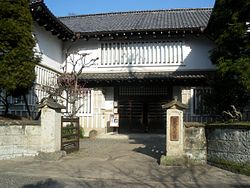
The Japan Folk Crafts Museum (Japanese: 日本民藝館, Hepburn: Nihon Mingeikan) is a museum in Komaba, Meguro, Tokyo, Japan, dedicated to the hand-crafted art of ordinary people (mingei). Access is from Komaba-Tōdaimae Station of Keio Inokashira Line.
The museum was established in 1936 by Yanagi Sōetsu, the founder of the mingei movement; Hamada Shōji succeeded him as its director. Yanagi and Hamada officially announced their desire to establish a folk crafts museum in 1926. Construction began on the museum in 1935 and was completed in 1936.
The museum covers 1,818 square meters and was constructed with a traditional Japanese architectural style. A 'long' stone-roofed gate-cum-residence (nagaya-mon) was brought from Tochigi Prefecture and reconstructed in front of the building.
See also
References
- Haruhara, Yoko (April 16, 2010). "Finding beauty in the simplest of things". The Japan Times. The Japan Times, Ltd. Retrieved 4 December 2011.
- "About the Mingeikan". Japan Folk Crafts Museum. Archived from the original on 10 May 2012. Retrieved 12 May 2012.
- ^ Soetsu Yanagi (2019). The Beauty of Everyday Things. Penguin Classics. pp. 327f. ISBN 9780241366356.
35°39′39″N 139°40′45″E / 35.66083°N 139.67917°E / 35.66083; 139.67917
External links
- Official site Archived 2008-12-21 at the Wayback Machine
This article related to a museum in Japan is a stub. You can help Misplaced Pages by expanding it. |